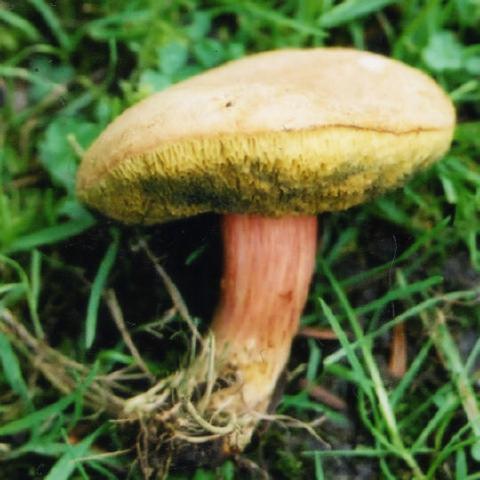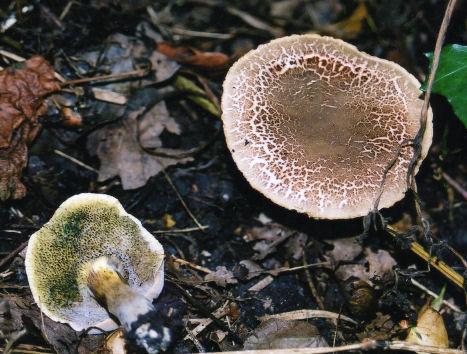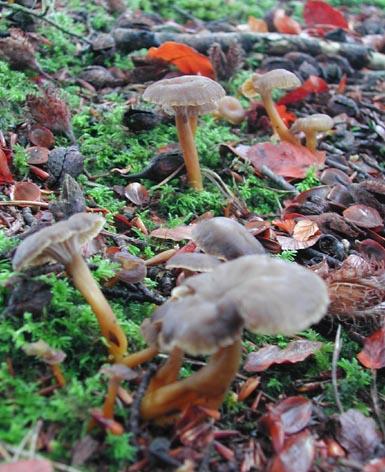|
|
 |
Author |
|
| Message |  |
|
mimborin
Joined: 24 Oct 2006
Posts: 895
Location: near Southampton/ Winchester (Romsey)
|
|
|
|
 |
mimborin
Joined: 24 Oct 2006
Posts: 895
Location: near Southampton/ Winchester (Romsey)
|
|
|
|
 |
cab
Joined: 01 Nov 2004
Posts: 32429
|
|
|
|
 |
Stewy
Joined: 17 Oct 2005
Posts: 1453
Location: Berkshire
|
|
|
|
 |
cab
Joined: 01 Nov 2004
Posts: 32429
|
|
|
|
 |
cab
Joined: 01 Nov 2004
Posts: 32429
|
|
|
|
 |
cab
Joined: 01 Nov 2004
Posts: 32429
|
 Posted: Tue Oct 31, 06 12:44 am Post subject: Posted: Tue Oct 31, 06 12:44 am Post subject: |
 
|
Boletus chrysenteron, the red (or pink) cracking bolete


Little thing, rarely more than 10 or 11cm across, not much taller, stem striated pinky yellow, yellow pores that stain greenish when you bruise them in most specimens, cap that starts brown and cracks to red. Grows in association with tree roots, usually broad leaved but doesn't seem to be entirely fussy which ones.
Often maligned as an edible, being rathery gooey. But when dried its excellent.
Last edited by cab on Tue Oct 31, 06 1:03 am; edited 1 time in total |
|
|
|
 |
cab
Joined: 01 Nov 2004
Posts: 32429
|
|
|
|
 |
cab
Joined: 01 Nov 2004
Posts: 32429
|
|
|
|
 |
gregreeve
Joined: 19 Oct 2006
Posts: 11
Location: Wiltshire
|
|
|
|
 |
cab
Joined: 01 Nov 2004
Posts: 32429
|
|
|
|
 |
doctoral
Joined: 19 Oct 2006
Posts: 697
Location: Now in Surrey ... I need a good avatar
|
|
|
|
 |
cibi
Joined: 23 Oct 2006
Posts: 35
Location: Central Scotland
|
 Posted: Fri Nov 10, 06 5:51 pm Post subject: Trumpet Chanterelle Posted: Fri Nov 10, 06 5:51 pm Post subject: Trumpet Chanterelle |
 
|
These one should be the Trumpet Chanterelle, Craterellus tubaeformis (Well I'm still alive after a few month of heavy consumption  ). ).
In deciduous woodlands, cap up to 5-6cm, brown, trumpet shape with sometimes a hole going all the way down the stem, can be round or quite wavy on the older ones. Stem is yellowish and hollow, usually the only thing you see as they are very well camouflaged. Spore print whitish, yellow. Gills is the way to recognise as they're vein-like rather than gills, a bit like the chanterelles.
LOADS of them up here, picked up kilos, and they're suppose to last later in the season! 
Not a big meal in themselves but really easy to dry whole, and tasty fried in butter or in omelettes.



another description at: https://www.mushroomexpert.com/craterellus_tubaeformis.html |
|
|
|
 |
Zarza
Joined: 22 Oct 2006
Posts: 91
Location: Either in the kitchen or in the woods, or in between
|
|
|
|
 |
jp
Joined: 09 Nov 2006
Posts: 302
Location: Salisbury, Wiltshire
|
|
|
|
 |
|
